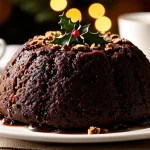Key Flavor Profile of Traditional British Christmas Pudding
Explore the British Christmas pudding flavors, where a distinctive blend of rich dried fruits, warming spices, citrus zest, and luscious sweeteners creates its signature taste. The main ingredients such as raisins, currants, and sultanas provide a natural sweetness and chewy texture, essential to the pudding’s character. Complementing these are fresh lemon and orange zest, which add brightness and aromatic lift amidst the dense, rich base.
Alcohol—most commonly brandy or rum—is pivotal. It infuses the pudding with depth, allowing flavors to meld during long steaming and maturation. This not only heightens aroma but also contributes a subtle warmth and complexity that gently lingers on the palate. Likewise, traditional fats like beef suet—or modern vegetable alternatives—imbue the pudding with richness, ensuring a moist, tender crumb.
In the same genre : How do you make a classic sticky toffee pudding?
The secret lies in the careful balance and layering of flavors: sweet, tangy, spicy, and boozy notes come together harmoniously. This interplay defines the classic dessert, offering a comforting yet vibrant flavor experience that has delighted generations during the festive season. The combination of ingredients isn’t random; it’s a refined symphony of tastes that embody the essence of British Christmas pudding flavors.
Core Ingredients Defining the Flavor
The dried fruit trio—raisins, currants, and sultanas—forms the backbone of British Christmas pudding flavors. These fruits provide more than just sweetness; their chewy texture enhances mouthfeel, making the pudding satisfyingly dense. Without these dried fruits, the signature taste loses much of its traditional character.
Also to discover : What tips can enhance your homemade fish and chips experience?
Citrus zest, primarily from lemon and orange, injects brightness and aromatic freshness. This sharp contrast cuts through the pudding’s richness, balancing the naturally sweet and heavy components. The oils released from these zests offer a fragrant lift that complements the dense dried fruit.
Suet, traditionally beef fat, plays a crucial role in maintaining moisture and richness in the pudding. Its melting property during steaming creates a tender, moist texture that is key to the flavor experience. Modern vegetable suet substitutes exist, replicating this effect while catering to diverse diets; however, the flavor and mouthfeel may subtly differ.
Together, these main ingredients—dried fruit, citrus zest, and suet—interact closely to define the core flavor components of British Christmas pudding flavors. Their roles are distinct yet harmonized, delivering the renowned texture and taste that characterize this classic dessert.
Core Ingredients Defining the Flavor
The foundation of British Christmas pudding flavors lies in its thoughtful mix of dried fruit, citrus zest, and suet. Raisins, currants, and sultanas serve as the main ingredients, providing not just natural sweetness but the distinct chewy texture crucial to the pudding’s character. Their concentrated sugars help balance the moisture and richness, anchoring the signature taste.
Citrus zest—typically lemon and orange—is more than a fragrance addition. It injects bright, fresh notes that cut through the dense richness, adding layers that keep the pudding flavorful instead of heavy. This citrus aroma is essential in bringing balance to the overall profile.
Traditional recipes call for beef suet, a fat that contributes to a moist, tender crumb and lends a depth of richness that supports the flavors. Many modern versions use vegetable suet alternatives to maintain this richness without animal fats, preserving the pudding’s moist texture.
Together, these flavor components interact harmoniously with spices and alcohol, creating the complex layering that defines the classic British Christmas pudding flavors. This blending of dried fruit sweetness, citrus brightness, and suet richness forms the essential backbone supporting all other taste elements.
Spices and Sweeteners in the Pudding
The Christmas pudding spices are crucial to shaping its warm, inviting flavor. Cinnamon, nutmeg, and cloves stand out as the primary spices, each contributing distinctive warmth and aromatic depth. Cinnamon offers a sweet, woody note; nutmeg introduces a slightly nutty, spicy quality; while cloves deliver a powerful, pungent warmth. Together, they build a layered spice profile that enlivens the dense base of dried fruit and suet.
Sweeteners like dark brown sugar and molasses deepen both flavor and color. Brown sugar provides a rich, caramel-like sweetness that complements the tartness of the dried fruits, while molasses adds robust, bittersweet notes, enhancing complexity. These sweeteners also contribute to the pudding’s moist texture and traditional dark hue.
Family and regional variations often emerge through subtle differences in spice blends and sweetener proportions. Some recipes emphasize more cloves for a stronger spice presence, while others highlight cinnamon’s softness. Similarly, the balance between brown sugar and molasses can shift, tailoring the pudding’s sweetness and richness to personal or local tastes.
In sum, Christmas pudding spices combined with the right sweeteners are essential to crafting the dessert’s signature taste, enhancing the main ingredients and reinforcing the classic British Christmas pudding flavors.



